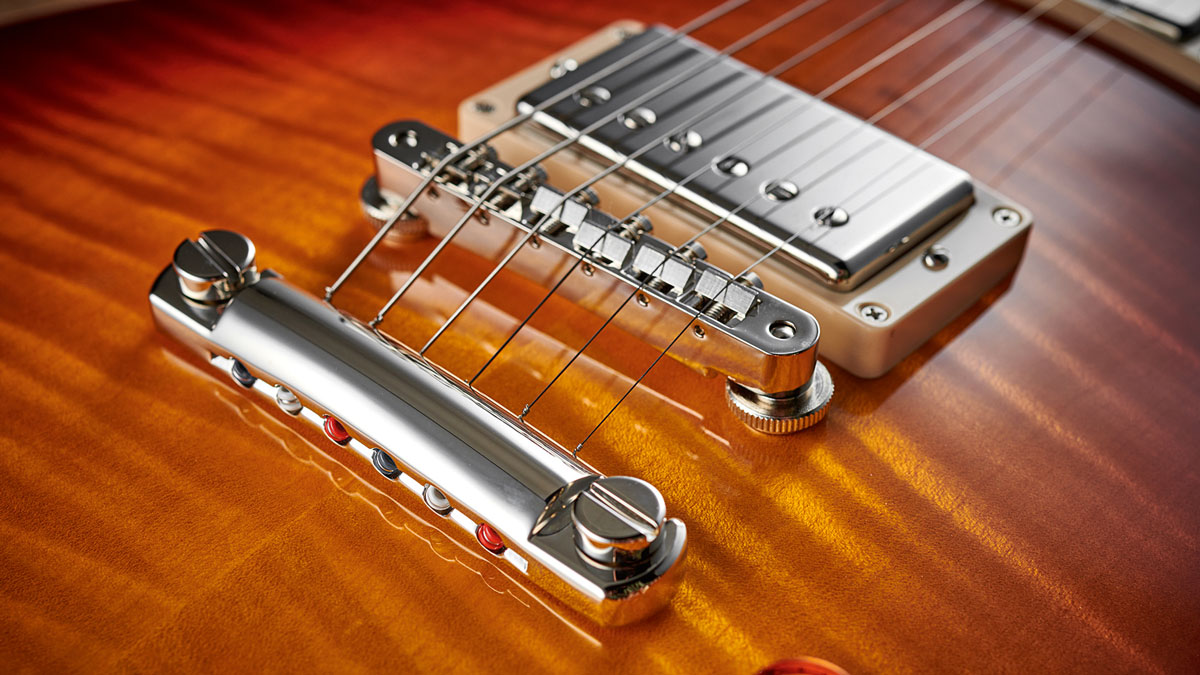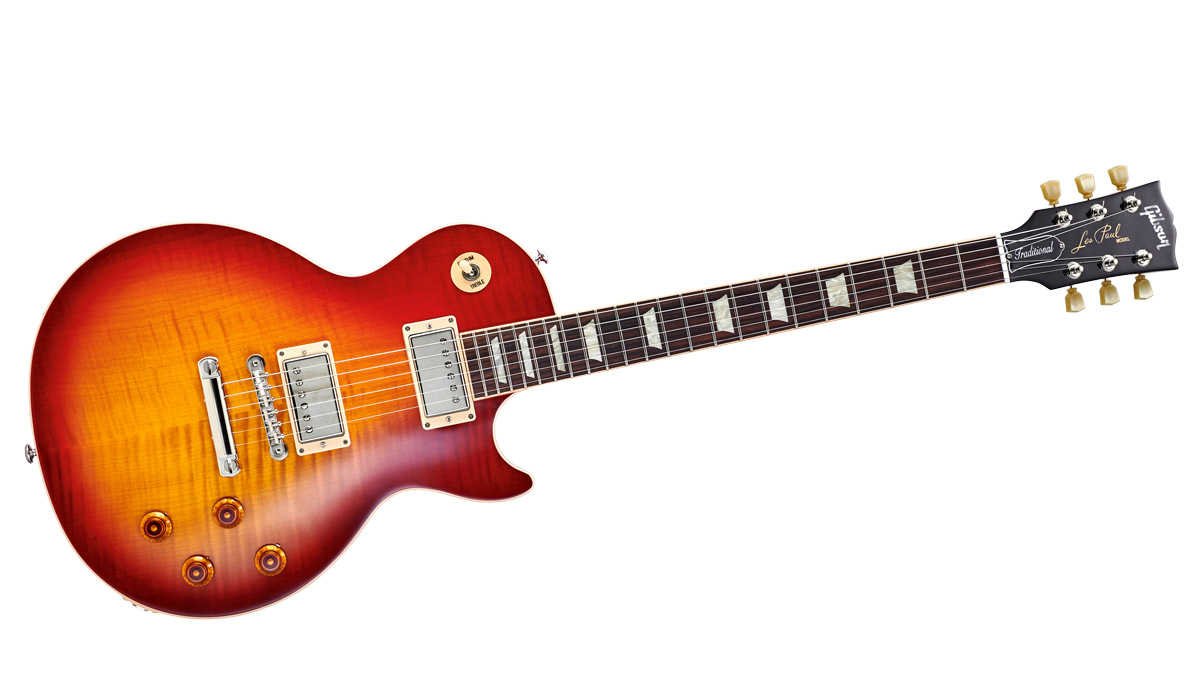MusicRadar Verdict
A Traditional Les Paul in every sense, and one that's bound to please purists.
Pros
- +
Tidy build with a most classic feel.
- +
There’s no weight relief or compound radius here and appealing beef to the neck shape.
- +
Nicely voiced pickups match the style.
Cons
- -
Wouldn’t vintage-style wiring be more appropriate here?
MusicRadar's got your back
While Fender splits its guitars into series and periodically updates or refreshes them, Gibson’s main USA production division prefers the annual makeover approach.
This year’s line-up was seen by many dealers as a return to form: “A new chapter in Gibson’s illustrious history, with their focus firmly back on crafting only the world’s finest guitars!” said one. As ever, the Les Paul sits central, with eight models (if we count The Paul 40th Anniversary) bookended by the start-up double-cut Les Paul Junior Tribute and topped off with the Les Paul High Performance. Add to the list the Les Paul Studio and Studio Tribute, and that leaves us with the three most classic Les Pauls, the Standard, Traditional and Classic. Today, we’re looking at the Traditional.
As its name implies, the Traditional is closest to the Les Paul we’ve known and loved over the past six and a bit decades and that’s reflected in its colour options, the only change for 2019. At launch it was offered in Tobacco Burst, Heritage Cherry Sunburst, Manhattan Midnight and Transparent Cherry Red; latterly it’s just the Heritage Cherry Sunburst (as here) and Tobacco Burst.

Outwardly, all three of the 2019 models share the same construction (one-piece neck, headstock widening wings and two-piece centre- joined backs), with the maple top grade on the Traditional rated as AA. The Traditional’s top is not in an ultra-blingy style, with a classic striping that, in this finish, helps this model to edge up on our favourite list before we’ve even played a note.
The Traditional is old-school with a hand-wired loom and Sprague orange drop caps. It uses Gibson Burstbuckers: a 1 and 2.
Sound
If you believe old is best, the Traditional is probably the Les Paul for you. It has no truck with weight relief, and although slightly heavier than our Standard it’s still nicely under 4kg/9lb. The neck, too, will appeal to those players who prefer an older style with more front-to-back taper (4.2mm) and a bigger, rounded feel.
In many ways, the Traditional is the Fender American Original of this interim Les Paul line-up: it’s the most vintage spec before you get into the Gibson Custom Historics. It looks great with that deep red ’Burst to the front and the lovely red hue to the rest of the guitar, but it’s the simplistic drive that makes it such a pleasure.
The crisp, clean acoustic response gets the guitar working as it should with an almost second bloom to the sustain tail - so much a part of this classic design. The Traditional has a subtly, vintage-y voice - snappy with volume reduction and smooth in the highs.
Unplugged, the Traditional is a beauty. But it’s more than that: the good weight (without weight relief ), the bigger neck... it feels like a good Les Paul and looks the part.
It will no doubt be a while until ‘new Gibson’ settles in and has a noticeable effect on the instruments we can buy. These interim models, however, are three strong dishes that employ existing features we’ve seen before, albeit not in quite the same combinations. With the horrors of ‘robotic’ tuners, over-wide necks and zero frets now pretty much consigned to the past, this Traditional model zones in on the Les Paul in classic style.
This might well be a quite historic model, too: the end of an era. Just as we conclude our test at the start of 2019, the new Gibson management announced there will apparently be a completely new 2019 range of ‘Classics’: “Designs like the Les Paul and the SG once again embrace the features and construction details that made them legends in the first place: a Les Paul Standard ’50s spec and a Les Paul Standard ’60s spec as well as one with P-90 pickups,” says Cesar Gueikian, Gibson’s chief merchant officer. “The Contemporary line also introduces a new concept with the Les Paul and SG Modern.” These new ranges “will be available for purchase later this year”.
What that means for the original and clearly short-lived 2019 models that are in-store is anyone’s guess, but we suspect as the year progresses there will be deals aplenty to be had (2018 models are already discounted in many stores). Whatever happens while the dust settles, it looks like 2019 is going to be quite a year for Gibson lovers. Watch this space!
Dave Burrluck is one of the world’s most experienced guitar journalists, who started writing back in the '80s for International Musician and Recording World, co-founded The Guitar Magazine and has been the Gear Reviews Editor of Guitarist magazine for the past two decades. Along the way, Dave has been the sole author of The PRS Guitar Book and The Player's Guide to Guitar Maintenance as well as contributing to numerous other books on the electric guitar. Dave is an active gigging and recording musician and still finds time to make, repair and mod guitars, not least for Guitarist’s The Mod Squad.
““We were arguing a lot and we were miserable”: How Green Day exceeded expectations with their most ambitious song
"There’s plenty for us guitarists to learn – and ‘less is more’ is the overriding lesson": how to play like George Harrison on The Beatles' Abbey Road
“They didn’t like Prince’s bikini underwear”: Prince’s support sets for the The Rolling Stones in 1981 are remembered as disastrous, but guitarist Dez Dickerson says that the the crowd reaction wasn’t as bad as people think











